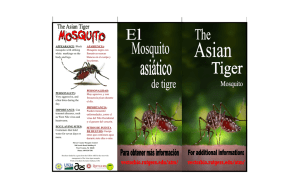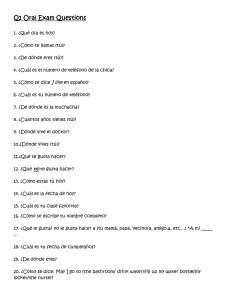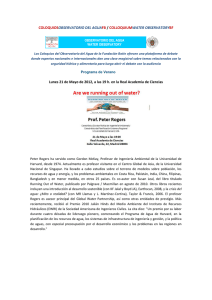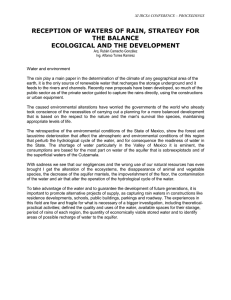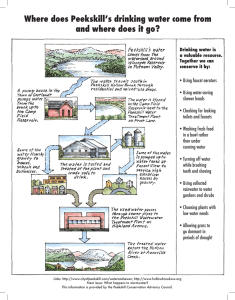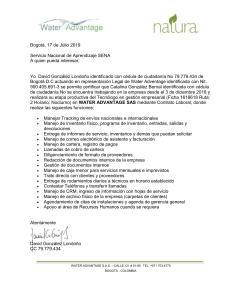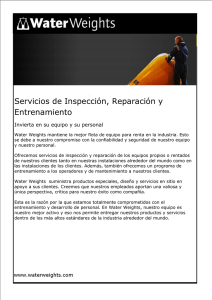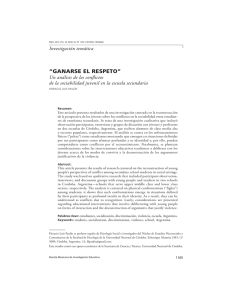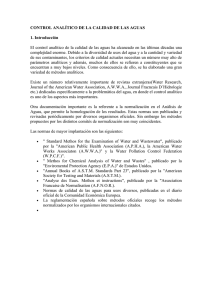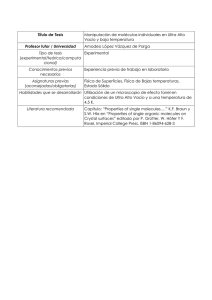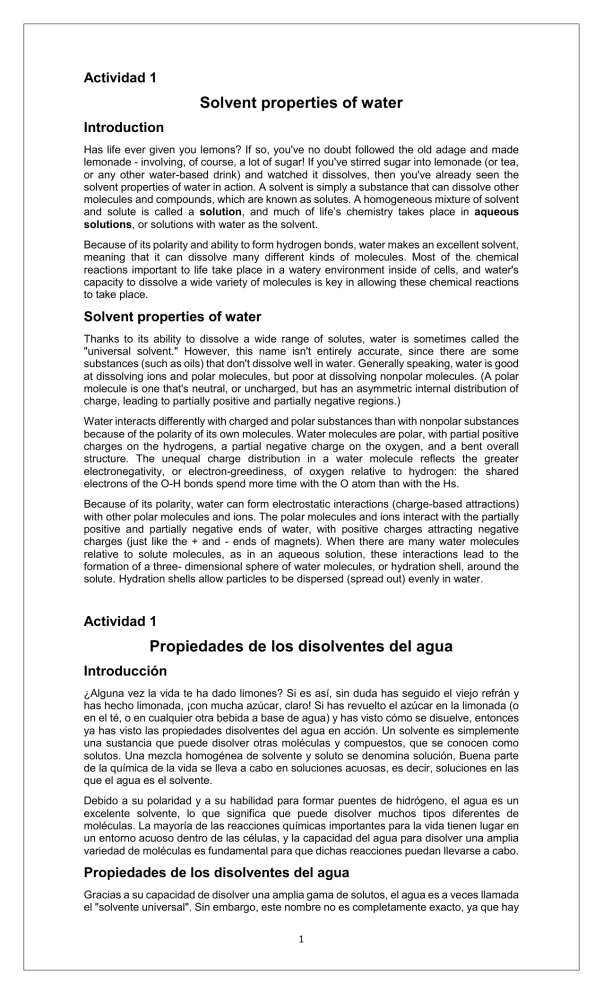
Actividad 1 Solvent properties of water Introduction Has life ever given you lemons? If so, you've no doubt followed the old adage and made lemonade - involving, of course, a lot of sugar! If you've stirred sugar into lemonade (or tea, or any other water-based drink) and watched it dissolves, then you've already seen the solvent properties of water in action. A solvent is simply a substance that can dissolve other molecules and compounds, which are known as solutes. A homogeneous mixture of solvent and solute is called a solution, and much of life’s chemistry takes place in aqueous solutions, or solutions with water as the solvent. Because of its polarity and ability to form hydrogen bonds, water makes an excellent solvent, meaning that it can dissolve many different kinds of molecules. Most of the chemical reactions important to life take place in a watery environment inside of cells, and water's capacity to dissolve a wide variety of molecules is key in allowing these chemical reactions to take place. Solvent properties of water Thanks to its ability to dissolve a wide range of solutes, water is sometimes called the "universal solvent." However, this name isn't entirely accurate, since there are some substances (such as oils) that don't dissolve well in water. Generally speaking, water is good at dissolving ions and polar molecules, but poor at dissolving nonpolar molecules. (A polar molecule is one that's neutral, or uncharged, but has an asymmetric internal distribution of charge, leading to partially positive and partially negative regions.) Water interacts differently with charged and polar substances than with nonpolar substances because of the polarity of its own molecules. Water molecules are polar, with partial positive charges on the hydrogens, a partial negative charge on the oxygen, and a bent overall structure. The unequal charge distribution in a water molecule reflects the greater electronegativity, or electron-greediness, of oxygen relative to hydrogen: the shared electrons of the O-H bonds spend more time with the O atom than with the Hs. Because of its polarity, water can form electrostatic interactions (charge-based attractions) with other polar molecules and ions. The polar molecules and ions interact with the partially positive and partially negative ends of water, with positive charges attracting negative charges (just like the + and - ends of magnets). When there are many water molecules relative to solute molecules, as in an aqueous solution, these interactions lead to the formation of a three- dimensional sphere of water molecules, or hydration shell, around the solute. Hydration shells allow particles to be dispersed (spread out) evenly in water. Actividad 1 Propiedades de los disolventes del agua Introducción ¿Alguna vez la vida te ha dado limones? Si es así, sin duda has seguido el viejo refrán y has hecho limonada, ¡con mucha azúcar, claro! Si has revuelto el azúcar en la limonada (o en el té, o en cualquier otra bebida a base de agua) y has visto cómo se disuelve, entonces ya has visto las propiedades disolventes del agua en acción. Un solvente es simplemente una sustancia que puede disolver otras moléculas y compuestos, que se conocen como solutos. Una mezcla homogénea de solvente y soluto se denomina solución, Buena parte de la química de la vida se lleva a cabo en soluciones acuosas, es decir, soluciones en las que el agua es el solvente. Debido a su polaridad y a su habilidad para formar puentes de hidrógeno, el agua es un excelente solvente, lo que significa que puede disolver muchos tipos diferentes de moléculas. La mayoría de las reacciones químicas importantes para la vida tienen lugar en un entorno acuoso dentro de las células, y la capacidad del agua para disolver una amplia variedad de moléculas es fundamental para que dichas reacciones puedan llevarse a cabo. Propiedades de los disolventes del agua Gracias a su capacidad de disolver una amplia gama de solutos, el agua es a veces llamada el "solvente universal". Sin embargo, este nombre no es completamente exacto, ya que hay 1 algunas sustancias (como los aceites) que no se disuelven bien en el agua. En términos generales, el agua es buena para disolver los iones y las moléculas polares, pero mala para disolver las moléculas no polares. (Una molécula polar es aquella que es neutral, no tiene una carga neta, pero tiene una distribución interna de cargas que forman una región parcialmente positiva y una región parcialmente negativa). El agua interactúa de manera diferente con las sustancias polares y no polares debido a la polaridad de sus propias moléculas. Las moléculas de agua son polares, con cargas parciales positivas en los hidrógenos, una carga parcial negativa en el oxígeno y una estructura general angular. La distribución desigual de las cargas en una molécula de agua refleja la mayor electronegatividad, o capacidad de generar electrones, del oxígeno en relación con el hidrógeno: los electrones compartidos de los enlaces O-H pasan más tiempo con el átomo O que con el H. Debido a su polaridad, el agua puede formar interacciones electrostáticas (atracciones basadas en cargas) con otras moléculas polares y con iones. Las moléculas polares e iones interactúan con los extremos parcialmente positivos y parcialmente negativos del agua, con cargas positivas que atraen cargas negativas (como en los extremos + y - de los imanes). Cuando hay muchas moléculas de agua en relación con las moléculas del soluto, como en una solución acuosa, estas interacciones conducen a la formación de una esfera tridimensional de moléculas de agua, llamada capa de hidratación, alrededor del soluto. Las capas de hidratación permiten que las partículas se dispersen (se distribuyan) uniformemente en el agua. 2 Vocabulario. Adage: Adagio, Dicho o Refrán Solvent: Solvente o Disolvente Ability: Habilidad o Capacidad Bonds: Enlaces, Puentes o Vínculos Bent: Doblado, Curvado o Angular Shell: Cascara o Capa spread out: Dispersarse, Separarse o Distribuirse Actividad 2 MOSQUITO BITES When we are young, we learn that tigers and sharks are dangerous animals. We might be scared of them because they are big and powerful. As we get older, however, we learn that sometimes the most dangerous animals are also the smallest animals. In fact, the animal that kills the most people every year is one that you have probably killed yourself many times: the mosquito. While it may seem that all mosquitoes are biters, this is not actually the case. Male mosquitoes eat plant nectar. On the other hand, female mosquitoes feed on animal blood. They need this blood to live and produce eggs. When a female mosquito bites a human being, it transmits a small amount of saliva into the blood. This saliva may or may not contain a deadly disease. The result of the bite can be as minor as an itchy bump or as serious as death. Because a mosquito can bite many people in the course of its life, it can carry diseases from one person to another very easily. Two of the most deadly diseases carried by mosquitoes are malaria and yellow fever. More than 700 million people become sick from these diseases every year. At least 2 million of these people will die from these diseases. Many scientists are working on safer and better ways to kill mosquitoes, but so far, there is no sure way to protect everyone in the world from their deadly bites. Mosquito nets can be placed over beds to protect people against being bitten. These nets help people stay safe at night, but they do not kill any mosquitoes. Mosquitoes have many natural enemies like bats, birds, dragonflies, and certain kinds of fish. Bringing more of these animals into places where mosquitoes live might help to cut down the amount of mosquitoes in that area. This is a natural solution, but it does not always work very well. Mosquitoes can also be killed 2 with poisons or sprays. Even though these sprays kill mosquitoes, they may also harm other plants or animals. Although mosquitoes may not seem as scary as larger, more powerful animals, they are far more dangerous to human beings. But things are changing. It is highly likely that one day scientists will find a way to keep everyone safe from mosquitoes and the diseases they carry. CHOOSE THE BEST DEFINITION. CHOOSE JUST ONE AND ANSWER. 1) According to the author, some people are more afraid of tigers and sharks than mosquitoes because tigers and sharks A. kill more people than mosquitoes B. are big and powerful 2) Based on the information in paragraph 2, we can understand that A. male mosquitoes eat meat B. female mosquitoes are responsible for transmitting diseases to humans 3) In paragraph 2 the author writes, "This saliva may or may not contain a deadly disease." By this statement he means that A. is the saliva that may transmit a deadly disease B. the mosquito saliva is always clean 4) As used in paragraph 2, minor means A. insignificant B. frustrating 5) Based on information in paragraph 3, it can be understood that A. only 2 million out of 700 million will die of malaria and yellow fever B. 700 million people will die of malaria and yellow fever 6) A natural solution to kill mosquitoes is A. to use poisons and sprays B. bring animals like bats, dragonflies and certain kinds of fish 7) In reference to poisons and sprays, it seems that they A. kill mosquitoes only B. may also harm other plants and animals 8) Nets over the top of beds A. provide people adequate protection from deadly mosquitoes. B. help mosquitoes to infect people Webgrafía 1. https://www.deepl.com/translator accesado el 11 de septiembre del 2020 2. https://www.wordreference.com/ accesado el 11 de septiembre del 2020 3 4
